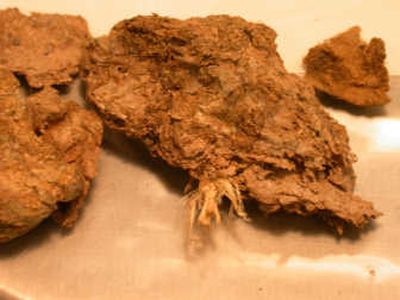Oldest American human remains found

Scientists have found and dated the oldest human remains ever uncovered in the Americas – a discovery that places people genetically similar to Native Americans in Oregon more than 14,000 years ago.
Working with radiocarbon dating and DNA analysis, an international team concluded that fossilized feces found five feet below the surface of an arid cave are almost 1,000 years older than any previous human remains unearthed in the Americas.
The samples were discovered close to a crude dart or spear tip chiseled from obsidian, as well as bones of horses and camels that were then common in the region. The researchers described their finding as a “smoking gun” in the long-running debate over when and where humans first inhabited the New World.
“What’s so exciting here is that we have cells from real people, their DNA, rather than samples of their work or technologies,” said Dennis Jenkins of the University of Oregon, who oversaw the cave site dig. “And we have them on the Oregon landscape 1,000 years before what used to be the earliest samples of human remains in the Americas.”
The discovery, published Thursday in the online edition of the journal Science, is a blow to the widely held theory that the Clovis culture – named after a site in New Mexico where its distinct artifacts and fluted spearheads were first identified in the 1930s – was the first human presence in North America. Jenkins said that while the human DNA found in Oregon could be from ancestors of the Clovis culture, none of the distinctive Clovis-era technology has been found in the region.
The “Clovis-first” theory has been challenged by almost a decade of discoveries from Canada to the southern tip of South America that indicate that humans were present before the time of the Clovis civilization, generally dated about 13,000 years ago. But Thursday’s report is considered key because it is the first to involve datable human DNA.
The discovery, however, is not without its critics. The cave has been excavated in the past, leading some to wonder whether the newly found samples were contaminated and mixed with other material. In addition, some of the fossilized feces, called coprolites, contain canine DNA.
“I don’t think we know for sure whether these are dog coprolites or human,” said Gary Haynes, an anthropologist at the University of Nevada, Reno. “We know that Native Americans have used these sites for centuries, and so their DNA could have gotten into the older dog feces through urination.”
The team rejects this possibility, saying there’s too much human protein found in the oldest coprolites to be explained by later human activities. They also say the presence of human hair in the coprolites makes it almost irrelevant whether they came from humans or dogs, because the two appeared to be living together in the early times established by radiocarbon dating.
If the discovery is ultimately confirmed and accepted by anthropologists, it will also challenge the prevailing theory about how humans spread across the Americas.
Most experts agree that the first American inhabitants traveled across what was then a land and ice bridge across the Bering Straits from Siberia to Alaska, most likely before 15,000 years ago. But much of Canada was then covered by an ice sheet that would have made it impossible to migrate southward.
Using geological and climate information, researchers have concluded that a corridor of ice-free land opened up in inland Canada between 13,000 and 12,000 years ago and that the earliest inhabitants could have made their way down to the high plains of the United States by that path. Humans are believed to have then spread quickly across North and then South America – doing so in hundreds, rather than thousands of years.
But if very early humans lived in Oregon, that suggests they either came directly from Asia by boat or traveled down the Pacific coastline after crossing the land bridge.
While the origin of the newly discovered early human DNA is an inevitable source of jokes, researchers say that coprolites are an important reservoir of historical genetic information that can be mined with increasing sophistication. Fourteen samples of the feces were sent to the University of Copenhagen for DNA analysis, and six were found to have human DNA. Using coprolites also avoids the sensitive issue of whether Native American skeletal remains should be exhumed and studied.
According to DNA specialist Eske Willerslev, an author of the paper, the DNA was of a distinctive Native American grouping – similar to some early people from Central Asia, but different in some important ways. He said because the DNA samples were broken and, as a result, were hard to read, the researchers could not be more specific about the genetic make-up of the people. He said he sent samples to other DNA labs in Sweden and Germany that came back with the same results.
The fossilized waste was found in 2002 and 2003 in one of eight caves and covered ledges along the Paisley ridge in south-central Oregon.
The site was first studied in the 1930s as a home to early humans, but those researchers’ ability to analyze their finds was far more limited than it is today.
Jenkins said the feces were easy to identify, even though they were well buried. In the thin, finely ground dirt, the fossilized coprolites were unmistakable. “Basically it looks like what it is – poop,” he said. “Dried up like that, it maintains its shape and is very different from the surrounding soil.”
Using more controlled excavation methods, he and his team have dug up other samples that will be radiocarbon-dated and DNA-analyzed as well.